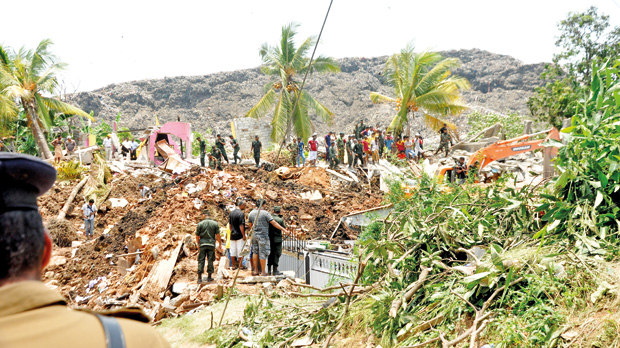Art of compensating victims of natural disasters

 festivities and happiness. Killing as many as 32 people in its wake while leaving many others orphaned and destitute, the massive garbage slide was one of the most devastating man-made disasters in the history of Sri Lanka. While compensation and relief measures for those left destitute and orphaned are currently underway, the extent to which such relief schemes have been effective in addressing victims’ grievances are yet to be unravelled. In an attempt to shed more light into the matter including how the Government provides relief measures when encountered with a disaster, Daily Mirror spoke to several individuals to get their expert opinion on the subject.
festivities and happiness. Killing as many as 32 people in its wake while leaving many others orphaned and destitute, the massive garbage slide was one of the most devastating man-made disasters in the history of Sri Lanka. While compensation and relief measures for those left destitute and orphaned are currently underway, the extent to which such relief schemes have been effective in addressing victims’ grievances are yet to be unravelled. In an attempt to shed more light into the matter including how the Government provides relief measures when encountered with a disaster, Daily Mirror spoke to several individuals to get their expert opinion on the subject.

 Speaking to Daily Mirror, Secretary of the Ministry of Disaster Management S. S. Miyanawala said that the Govt does not allocate money for future disasters through its annual budget due to the unpredictable nature of natural disasters. However he said that since last April, the Govt has introduced a new insurance scheme through which compensation is delivered for victims of natural disasters. “It should be noted that this insurance scheme provides compensation only for those affected from natural disasters. For an instance, disasters such as the Salawa incident are compensated through the national treasury funds and not through this insurance scheme. It is difficult to allocate a said amount in particular for natural disasters through the annual Govt budget because the scales of natural disasters are very unpredictable by nature.
Speaking to Daily Mirror, Secretary of the Ministry of Disaster Management S. S. Miyanawala said that the Govt does not allocate money for future disasters through its annual budget due to the unpredictable nature of natural disasters. However he said that since last April, the Govt has introduced a new insurance scheme through which compensation is delivered for victims of natural disasters. “It should be noted that this insurance scheme provides compensation only for those affected from natural disasters. For an instance, disasters such as the Salawa incident are compensated through the national treasury funds and not through this insurance scheme. It is difficult to allocate a said amount in particular for natural disasters through the annual Govt budget because the scales of natural disasters are very unpredictable by nature.
Usually when a disaster occurs, the President summons an immediate meeting with the Disaster Management Task Force, which is responsible for compiling all information concerning the disaster including details of the relevant institutions directly involved with the subject. The relevant institutions will execute their actions under the direct instructions of the President”, Miyanawala added.
Adding that there is also an allocated budget for disaster reduction, the state official said that the main aim of this plan is to reduce the effects of a disaster. The Disaster Risk Reduction Plan (DRRP) was effective in the country since 2014. “In addition to the Ministry of Disaster Management, there are many other institutions involved with this programme. This also includes foreign agencies such as the World Bank who are involved with providing funds to continue the work of the DRRP. Currently, there are 43 projects that are carried out in the country under the plan” he said.
Upon inquiring about the progress of the ongoing relief efforts, he said that all compensation packages are being delivered to the victims of the Meethotamulla tragedy. He said that all measures have been taken to cater to the needs of victims by means of providing compensation. These compensation will take the form of either providing the victims with a house or proving a financial compensation for those who are not willing to shift to a new house.
 “68 houses were provided during last week for those affected by the disaster. So far, the number of houses that have been provided including the houses that were provided on Tuesday amount to ninety eight in total” says Deputy Director of the DMC, Pradeep Kodippili. He said that other victims would also be provided with houses with immediate effect including a financial relief amounting to Rs. 250,000 for furniture and Rs.10,000 for transporting purposes. In the event someone is willing to rent out a house, they would be granted Rs. 50,000 as house rent for three months.
“68 houses were provided during last week for those affected by the disaster. So far, the number of houses that have been provided including the houses that were provided on Tuesday amount to ninety eight in total” says Deputy Director of the DMC, Pradeep Kodippili. He said that other victims would also be provided with houses with immediate effect including a financial relief amounting to Rs. 250,000 for furniture and Rs.10,000 for transporting purposes. In the event someone is willing to rent out a house, they would be granted Rs. 50,000 as house rent for three months.
“The minor population still residing in relief camps would be provided with all relief measures and would be soon transferred to the temporary houses that have been built in the surroundings of the paddy cultivation stores. However, it is confirmed these individuals would also be given permanent houses in the near future. All victims, whose houses had been damaged or partially damaged, and the individuals whose houses are located in the vulnerable zone in Meethotamulla would be provided with new houses” Kodippili added.“The Meethotamulla disaster took place on April 14. Up to now we have provided 98 houses and this is the fastest relief scheme which has ever been conducted in disaster management sector in Sri Lanka. Therefore, I am positive that all victims of the tragedy would definitely get new houses as compensation without delay” he said.

2017-05-03
It has been more than two weeks since a section of the Meethotamulla garbage dump had collapsed, snuffing out the lives of many while casting a spell of gloom and despair on a day meant for
 festivities and happiness. Killing as many as 32 people in its wake while leaving many others orphaned and destitute, the massive garbage slide was one of the most devastating man-made disasters in the history of Sri Lanka. While compensation and relief measures for those left destitute and orphaned are currently underway, the extent to which such relief schemes have been effective in addressing victims’ grievances are yet to be unravelled. In an attempt to shed more light into the matter including how the Government provides relief measures when encountered with a disaster, Daily Mirror spoke to several individuals to get their expert opinion on the subject.
festivities and happiness. Killing as many as 32 people in its wake while leaving many others orphaned and destitute, the massive garbage slide was one of the most devastating man-made disasters in the history of Sri Lanka. While compensation and relief measures for those left destitute and orphaned are currently underway, the extent to which such relief schemes have been effective in addressing victims’ grievances are yet to be unravelled. In an attempt to shed more light into the matter including how the Government provides relief measures when encountered with a disaster, Daily Mirror spoke to several individuals to get their expert opinion on the subject. 
“Action taken under direct instruction of the President” - S. S. Miyanawala
Secretary - Ministry of Disaster Management
 Speaking to Daily Mirror, Secretary of the Ministry of Disaster Management S. S. Miyanawala said that the Govt does not allocate money for future disasters through its annual budget due to the unpredictable nature of natural disasters. However he said that since last April, the Govt has introduced a new insurance scheme through which compensation is delivered for victims of natural disasters. “It should be noted that this insurance scheme provides compensation only for those affected from natural disasters. For an instance, disasters such as the Salawa incident are compensated through the national treasury funds and not through this insurance scheme. It is difficult to allocate a said amount in particular for natural disasters through the annual Govt budget because the scales of natural disasters are very unpredictable by nature.
Speaking to Daily Mirror, Secretary of the Ministry of Disaster Management S. S. Miyanawala said that the Govt does not allocate money for future disasters through its annual budget due to the unpredictable nature of natural disasters. However he said that since last April, the Govt has introduced a new insurance scheme through which compensation is delivered for victims of natural disasters. “It should be noted that this insurance scheme provides compensation only for those affected from natural disasters. For an instance, disasters such as the Salawa incident are compensated through the national treasury funds and not through this insurance scheme. It is difficult to allocate a said amount in particular for natural disasters through the annual Govt budget because the scales of natural disasters are very unpredictable by nature. Usually when a disaster occurs, the President summons an immediate meeting with the Disaster Management Task Force, which is responsible for compiling all information concerning the disaster including details of the relevant institutions directly involved with the subject. The relevant institutions will execute their actions under the direct instructions of the President”, Miyanawala added.
Adding that there is also an allocated budget for disaster reduction, the state official said that the main aim of this plan is to reduce the effects of a disaster. The Disaster Risk Reduction Plan (DRRP) was effective in the country since 2014. “In addition to the Ministry of Disaster Management, there are many other institutions involved with this programme. This also includes foreign agencies such as the World Bank who are involved with providing funds to continue the work of the DRRP. Currently, there are 43 projects that are carried out in the country under the plan” he said.
Upon inquiring about the progress of the ongoing relief efforts, he said that all compensation packages are being delivered to the victims of the Meethotamulla tragedy. He said that all measures have been taken to cater to the needs of victims by means of providing compensation. These compensation will take the form of either providing the victims with a house or proving a financial compensation for those who are not willing to shift to a new house.
“People would be happy if promises are fulfilled on time” - Nuwan Bopage
Commenting on the extent to which compensation had been paid to victims, Movement Against  Meethotamulla Garbage Mound organiser, Attorney-at-law Nuwan Bopage said that most of the victims who were interested in moving to new houses have been already provided with new abodes. However he said that still there remain nearly 90 people who are left destitute. “These victims were given Rs.50,000 each by the Govt in order to rent a house. Initially, we had a discussion with the Premier and it was understood that the rent for three months would be paid as a lump sum since people are bound to make a payment in advance prior to renting a new house. However, when the victims went to claim their compensation last Monday, respective authorities have informed them that only the monthly rent amounting to Rs.50,000 could be paid to them as an initial step since the Treasury lacks sufficient funds to pay the three month rental at once” he said.
Meethotamulla Garbage Mound organiser, Attorney-at-law Nuwan Bopage said that most of the victims who were interested in moving to new houses have been already provided with new abodes. However he said that still there remain nearly 90 people who are left destitute. “These victims were given Rs.50,000 each by the Govt in order to rent a house. Initially, we had a discussion with the Premier and it was understood that the rent for three months would be paid as a lump sum since people are bound to make a payment in advance prior to renting a new house. However, when the victims went to claim their compensation last Monday, respective authorities have informed them that only the monthly rent amounting to Rs.50,000 could be paid to them as an initial step since the Treasury lacks sufficient funds to pay the three month rental at once” he said.
According to Bopage, the victims were therefore able to claim only the first rental of Rs. 50,000. However, he stated that as the Government has promised them, most victims did receive the promised Rs. 250, 000 provided for purchasing furniture.
“Instead of buying furniture, most victims utilized this money to pay the advance for renting a new house. The Govt has also promised the victims of the Meethotamulla tragedy that the damage to their houses would be estimated and evaluated by the Valuation Department; thereby making necessary arrangements to pay a financial compensation to victims for the loss they have incurred. Currently, officials representing the Valuation Department are carrying out their duties concerning this issue.
We have also requested the Govt that a financial compensation worth Rs. 5,000,000 should be paid for each life that was lost as a result of the collapse of a section of the garbage dump. So far, the Govt has made no comment concerning the compensation that would be paid for the loss of lives after the tragedy.
Although people in the slide-prone zone have been asked to evacuate their residences, these people have nowhere to go and to date they have not been paid any kind of financial compensation to move out of their houses either. Instead we request the Govt that the garbage dump be completely cleared in order to avoid the impending threat to people’s lives and properties. Although some of the promises given to the people have been fulfilled by the Govt, the people would be more happy if all given promises are fulfilled on time,” he added.
 Meethotamulla Garbage Mound organiser, Attorney-at-law Nuwan Bopage said that most of the victims who were interested in moving to new houses have been already provided with new abodes. However he said that still there remain nearly 90 people who are left destitute. “These victims were given Rs.50,000 each by the Govt in order to rent a house. Initially, we had a discussion with the Premier and it was understood that the rent for three months would be paid as a lump sum since people are bound to make a payment in advance prior to renting a new house. However, when the victims went to claim their compensation last Monday, respective authorities have informed them that only the monthly rent amounting to Rs.50,000 could be paid to them as an initial step since the Treasury lacks sufficient funds to pay the three month rental at once” he said.
Meethotamulla Garbage Mound organiser, Attorney-at-law Nuwan Bopage said that most of the victims who were interested in moving to new houses have been already provided with new abodes. However he said that still there remain nearly 90 people who are left destitute. “These victims were given Rs.50,000 each by the Govt in order to rent a house. Initially, we had a discussion with the Premier and it was understood that the rent for three months would be paid as a lump sum since people are bound to make a payment in advance prior to renting a new house. However, when the victims went to claim their compensation last Monday, respective authorities have informed them that only the monthly rent amounting to Rs.50,000 could be paid to them as an initial step since the Treasury lacks sufficient funds to pay the three month rental at once” he said. According to Bopage, the victims were therefore able to claim only the first rental of Rs. 50,000. However, he stated that as the Government has promised them, most victims did receive the promised Rs. 250, 000 provided for purchasing furniture.
“Instead of buying furniture, most victims utilized this money to pay the advance for renting a new house. The Govt has also promised the victims of the Meethotamulla tragedy that the damage to their houses would be estimated and evaluated by the Valuation Department; thereby making necessary arrangements to pay a financial compensation to victims for the loss they have incurred. Currently, officials representing the Valuation Department are carrying out their duties concerning this issue.
We have also requested the Govt that a financial compensation worth Rs. 5,000,000 should be paid for each life that was lost as a result of the collapse of a section of the garbage dump. So far, the Govt has made no comment concerning the compensation that would be paid for the loss of lives after the tragedy.
Although people in the slide-prone zone have been asked to evacuate their residences, these people have nowhere to go and to date they have not been paid any kind of financial compensation to move out of their houses either. Instead we request the Govt that the garbage dump be completely cleared in order to avoid the impending threat to people’s lives and properties. Although some of the promises given to the people have been fulfilled by the Govt, the people would be more happy if all given promises are fulfilled on time,” he added.
“98 houses given under fast track relief scheme” - Pradeep Kodippili, Deputy Director - DMC
 “68 houses were provided during last week for those affected by the disaster. So far, the number of houses that have been provided including the houses that were provided on Tuesday amount to ninety eight in total” says Deputy Director of the DMC, Pradeep Kodippili. He said that other victims would also be provided with houses with immediate effect including a financial relief amounting to Rs. 250,000 for furniture and Rs.10,000 for transporting purposes. In the event someone is willing to rent out a house, they would be granted Rs. 50,000 as house rent for three months.
“68 houses were provided during last week for those affected by the disaster. So far, the number of houses that have been provided including the houses that were provided on Tuesday amount to ninety eight in total” says Deputy Director of the DMC, Pradeep Kodippili. He said that other victims would also be provided with houses with immediate effect including a financial relief amounting to Rs. 250,000 for furniture and Rs.10,000 for transporting purposes. In the event someone is willing to rent out a house, they would be granted Rs. 50,000 as house rent for three months. “The minor population still residing in relief camps would be provided with all relief measures and would be soon transferred to the temporary houses that have been built in the surroundings of the paddy cultivation stores. However, it is confirmed these individuals would also be given permanent houses in the near future. All victims, whose houses had been damaged or partially damaged, and the individuals whose houses are located in the vulnerable zone in Meethotamulla would be provided with new houses” Kodippili added.“The Meethotamulla disaster took place on April 14. Up to now we have provided 98 houses and this is the fastest relief scheme which has ever been conducted in disaster management sector in Sri Lanka. Therefore, I am positive that all victims of the tragedy would definitely get new houses as compensation without delay” he said.
‘3R’ system to the rescue - Japanese Assessment Report
Presenting the Japanese Assessment Report on Meethotamulla to the President on Monday last week, the Head of the Experts Group Mitsutake Numahata elucidated the short-term and long-term measures, the Govt could employ to address the garbage issue in Meethotamulla effectively. Accordingly, it was reported that short term measures should ensure the stability of the garbage dump in order to prevent a possible collapse again.
It was also noted that the shape of the garbage dump should be streamlined with the base covered in polythene before the monsoon rain commences. Secondary measures also included recommendation to shape the dump symmetrically with a broad base. This would help in maintaining a proper distribution of the gravity. Long-term measures also included in the removal of the dump by employing the practice of ‘3-R’ system that stands for Reduce, Reuse and Recycle. Also the Japanese Assessment Report outlined the need for waste segregation in Meethotamulla garbage dump, including the need for a gas control and water drainage system in the area. It was also reported that public awareness should be raised on such issues in order to prevent further disasters.
It was also noted that the shape of the garbage dump should be streamlined with the base covered in polythene before the monsoon rain commences. Secondary measures also included recommendation to shape the dump symmetrically with a broad base. This would help in maintaining a proper distribution of the gravity. Long-term measures also included in the removal of the dump by employing the practice of ‘3-R’ system that stands for Reduce, Reuse and Recycle. Also the Japanese Assessment Report outlined the need for waste segregation in Meethotamulla garbage dump, including the need for a gas control and water drainage system in the area. It was also reported that public awareness should be raised on such issues in order to prevent further disasters.
